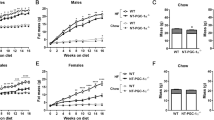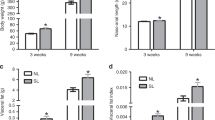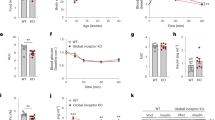Abstract
Background:
Osborne–Mendel (OM) rats are prone to obesity when fed a high-fat diet, whereas S5B/Pl (S5B) rats are resistant to diet-induced obesity when fed the same diet. OM rats have a decreased satiation response to fatty acids infused in the gastrointestinal tract, compared to S5B rats. One possible explanation is that OM rats are less sensitive to the satiating hormone, glucagon-like peptide 1 (GLP-1). GLP-1 is produced in the small intestine and is released in response to a meal. The current experiments examined the role of GLP-1 in OM and S5B rats.
Methods:
Experiment 1 examined preproglucagon mRNA expression in the ileum of OM and S5B rats fed a high-fat (55% kcal) or low-fat (10% kcal) diet. Experiment 2 investigated the effects of a 2 h high-fat meal after a 24 h fast in OM and S5B rats on circulating GLP-1 (active) levels. Experiment 3 examined the effects of exendin-4 (GLP-1 receptor agonist) administration on the intake of a high-fat or a low-fat diet in OM and S5B rats.
Results:
Preproglucagon mRNA levels were increased in the ileum of OM rats compared to S5B rats and were increased by high-fat diet in OM and S5B rats. OM and S5B rats exhibited a similar meal-initiated increase in circulating GLP-1 (active) levels. Exendin-4 dose dependently decreased food intake to a greater extent in S5B rats compared to OM rats. The intake of low-fat diet, compared to the intake of high-fat diet, was more sensitive to the effects of exendin-4 in these strains.
Conclusions:
These results suggest that though OM and S5B rats have similar preproglucagon mRNA expression in the ileum and circulating GLP-1 levels, OM rats are less sensitive to the satiating effects of GLP-1. Therefore, dysregulation of the GLP-1 system may be a mechanism through which OM rats overeat and gain weight.
This is a preview of subscription content, access via your institution
Access options
Subscribe to this journal
Receive 12 print issues and online access
$259.00 per year
only $21.58 per issue
Buy this article
- Purchase on Springer Link
- Instant access to full article PDF
Prices may be subject to local taxes which are calculated during checkout






Similar content being viewed by others
References
Barnes MJ, Holmes G, Primeaux SD, York DA, Bray GA . Increased expression of mu opioid receptors in animals susceptible to diet-induced obesity. Peptides 2006; 27: 3292–3298.
Greenberg D, McCaffery J, Potack JZ, Bray GA, York DA . Differential satiating effects of fats in the small intestine of obesity-resistant and obesity-prone rats. Physiol Behav 1999; 66: 621–626.
Ishihara Y, White CL, Kageyama H, Kageyama A, York DA, Bray GA . Effects of diet and time of the day on serum and CSF leptin levels in Osborne-Mendel and S5B/Pl rats. Obes Res 2004; 12: 1067–1076.
Liu X, York DA, Bray GA . Regulation of ghrelin gene expression in stomach and feeding response to a ghrelin analogue in two strains of rats. Peptides 2004; 25: 2171–2177.
Petrescu O, Cheema AF, Fan X, Bradbury MW, Berk PD . Differences in adipocyte long chain fatty acid uptake in Osborne-Mendel and S5B/Pl rats in response to high-fat diets. Int J Obes 2008; 32: 853–862.
Pittman D, Smith KR, Crawley ME, Corbin CH, Hansen DR, Watson KJ et al. Orosensory detection of fatty acids by obesity-prone and obesity-resistant rats: strain and sex differences. Chem Senses 2008; 33: 449–460.
Primeaux SD, Barnes MJ, Bray GA . Olfactory bulbectomy increases food intake and hypothalamic neuropeptide Y in obesity-prone, but not obesity-resistant rats. Behav Brain Res 2007; 180: 190–196.
White CL, Ishihara Y, York DA, Bray GA . Effect of meta-chlorophenylpiperazine and cholecystokinin on food intake of Osborne-Mendel and S5B/Pl rats. Obesity 2007; 15: 624–631.
Chaudhri O, Bloom SR . Gastrointestinal hormones regulating appetite. Philos Trans R Soc Lond B Biol Sci 2006; 361: 1187–1209.
Heijboer AC, Piji H, van den Hoek AM, Havekes LM, Romijn JA, Corssmit EP . Gut-brain axis: regulation of glucose metabolism. J Neuroendocrinol 2006; 18: 883–894.
Moran TH . Gut peptide signaling in the control of food intake. Obesity 2006; 14 (Suppl 5): 250S–253S.
Moran TH . Gut peptides in the control of food intake. Int J Obes 2009; 33: S7–S10.
Strader AD, Woods SC . Gastrointestinal hormones and food intake. Gastroenterology 2005; 128: 175–191.
Wren AM, Bloom SR . Gut hormones and appetite control. Gastroenterology 2007; 132: 2116–2130.
Beglinger C, Degen C . Gastrointestinal satiety signals in humans—physiologic roles for GLP-1 and PYY? Physiol Behav 2006; 89: 460–464.
Druce MR, Small CJ, Bloom SR . Minireview: gut peptides regulating satiety. Endocrinology 2004; 145: 2660–2665.
Holst JJ . Glucagonlike peptide 1: a newly discovered gastrointestinal hormone. Gastroenterology 1994; 107: 1848–1855.
Moran TH, Dailey MJ . Minireview: gut peptides: targets for antiobesity drug development? Endocrinology 2009; 150: 2526–2530.
Naslund E, Hellstrom PM . Glucagon-like peptide-1 in the pathogenesis of obesity. Drug News Perspect 1998; 11: 92–97.
Williams DL, Baskin DG, Schwartz MW . Leptin regulation of the anorexic response to glucagon-like peptide-1 receptor stimulation. Diabetes 2006; 55: 3387–3393.
Nakagawa A, Satake H, Nakabayashi H, Nishizawa M, Furuya K, Nakano S et al. Receptor gene expression of glucagon-like peptide-1, but not glucose-dependent insulinotropic polypeptide, in rat nodose ganglion cells. Auton Neurosci 2004; 110: 36–43.
Shughrue PJ, Lane MV, Merchenthaler I . Glucagon-like peptide-1 receptor (GLP1-R) mRNA in the rat hypothalamus. Endocrinology 1996; 137: 5159–5162.
Turton MD, O’Shea D, Gunn I, Beak SA, Edwards CM, Meeran K et al. A role for glucagon-like peptide-1 in the central regulation of feeding. Nature 1996; 379: 69–72.
Davis HR, Mullins DE, Pines JM, Hoos LM, France CF, Compton DS et al. Effect of chronic central administration of glucagon-like peptide 1 (7–36) amide on food consumption and body weight in normal and obese rats. Obes Res 1998; 6: 147–156.
Lin L, Chen J, York DA . Chronic ICV enterostatin preferentially reduced fat intake and lowered body weight. Peptides 1997; 18: 657–661.
Primeaux SD, York DA, Bray GA . Neuropeptide Y administration into the amygdala alters high fat food intake. Peptides 2006; 27: 1644–1651.
Primeaux SD, Blackmon C, Barnes MJ, Braymer HD, Bray GA . Central administration of the RFamide peptides, QRFP-26 and QRFP-43, increases high fat food intake in rats. Peptides 2008; 29: 1994–2000.
Drucker DJ . Minireview: the glucagon-like peptides. Endocrinology 2001; 142: 521–527.
Lopez LC, Frazier ML, Su CJ, Kumar A, Saunders GF . Mammalian pancreatic preproglucagon contains three glucagon-related peptides. Proc Natl Acad Sci USA 1983; 80: 5485–5489.
Tang-Christensen M, Vrang N, Larsen PJ . Glucagon-like peptide containing pathways in the regulation of feeding behaviour. Int J Obes Relat Metab Disord 2001; 25 (Suppl 5): S42–S47.
Holst JJ . Glucagon-like peptide 1 (GLP-1): an intestinal hormone, signalling nutritional abundance, with an unusual therapeutic potential. Trends Endocrinol Metab 1999; 10: 229–235.
Wynne K, Stanley S, McGowan B, Bloom S . Appetite control. J Endocrinol 2005; 184: 291–318.
Acknowledgements
This research was supported by NIH NIDDK 32089 to GA Bray and by NIDDK1P0DK072476. This work used the Animal Models and Phenotyping Core and the Genomics Core facilities that are supported in part by COBRE (NIH P20-RR021945) and NORC (1P30-DK072476) center grants from the National Institute of Health. We thank Christine Blackmon and Katherine Pyburn for their technical assistance on this project.
Author information
Authors and Affiliations
Corresponding author
Ethics declarations
Competing interests
The authors declare no conflict of interest.
Rights and permissions
About this article
Cite this article
Primeaux, S., Barnes, M., Braymer, H. et al. Sensitivity to the satiating effects of exendin 4 is decreased in obesity-prone Osborne–Mendel rats compared to obesity-resistant S5B/Pl rats. Int J Obes 34, 1427–1433 (2010). https://doi.org/10.1038/ijo.2010.78
Received:
Revised:
Accepted:
Published:
Issue Date:
DOI: https://doi.org/10.1038/ijo.2010.78
Keywords
This article is cited by
-
Striatal Rgs4 regulates feeding and susceptibility to diet-induced obesity
Molecular Psychiatry (2020)
-
High fat diet consumption differentially affects adipose tissue inflammation and adipocyte size in obesity-prone and obesity-resistant rats
International Journal of Obesity (2018)
-
High Fat Diet Differentially Regulates the Expression of Olfactory Receptors in the Duodenum of Obesity-Prone and Obesity-Resistant Rats
Digestive Diseases and Sciences (2013)
-
CD36 mRNA in the Gastrointestinal Tract Is Differentially Regulated by Dietary Fat Intake in Obesity-Prone and Obesity-Resistant Rats
Digestive Diseases and Sciences (2013)
-
GLP-1 and energy balance: an integrated model of short-term and long-term control
Nature Reviews Endocrinology (2011)



